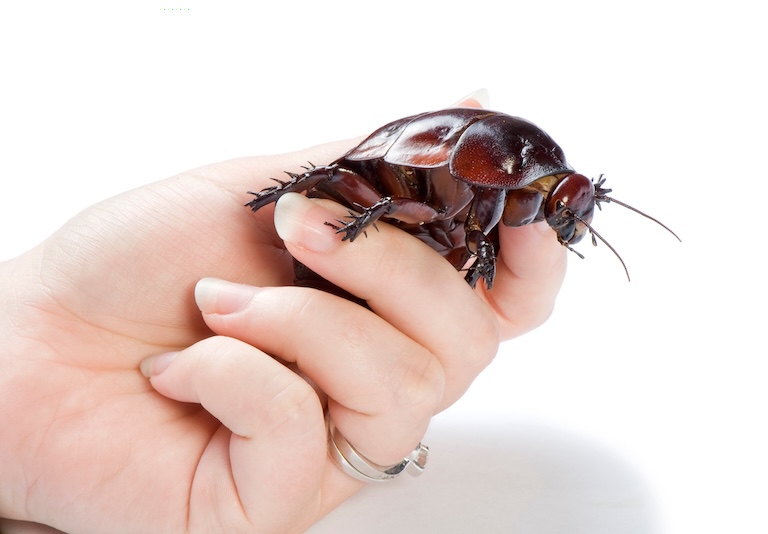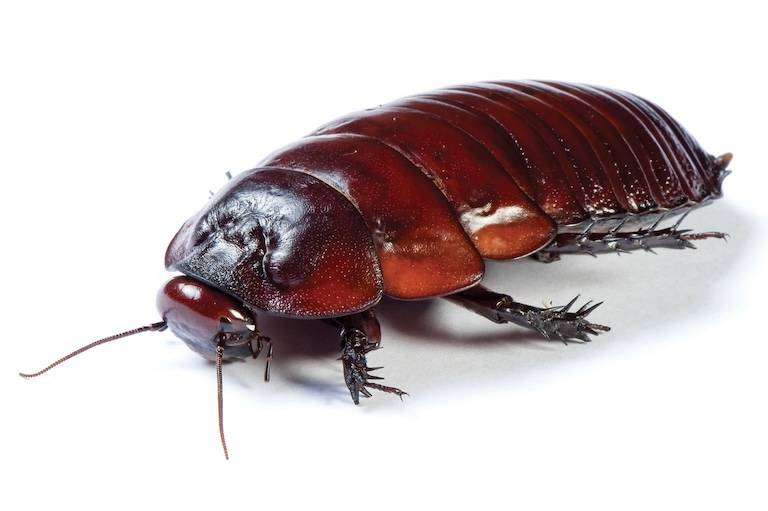Giant Burrowing Cockroach Profile
Like all animals that share common traits with humans, cockroaches get a bad rap; they’re resilient, social, eat almost anything and breed like crazy. They’re also quite creepy in many cases, especially when they fly.
But like spiders, the creepy factor seems inversely correlated to their speed and size, and some of the huge, slow ones become popular pets.
The heaviest of them all, the giant burrowing cockroach, is a slow-moving, wingless gentle giant and while it’s popular in captivity, it’s also a significant ecosystem engineer in the wild.

Giant Burrowing Cockroach Facts Overview
| Habitat: | Leaf litter under wooded areas, rainforests and savannas |
| Location: | Australia |
| Lifespan: | 10 years in captivity |
| Size: | Around 8 cm (3.2 in) long |
| Weight: | Up to 35 g (1.2 oz.) |
| Colour: | Dark, reddish brown |
| Diet: | Leaf litter, particularly Eucalyptus |
| Predators: | Large invertebrates like centipedes, likely birds, mammals |
| Top Speed: | Not listed |
| No. of Species: | 1 |
| Conservation Status: | Not listed |
Giant burrowing cockroaches are the heaviest of all cockroaches, despite having no wings. These are large, chunky animals well adapted to digging burrows amid eucalyptus forests, where they aerate the soil and contribute to composting and nutrient distribution.
With their shovel-like builds, they spend most of their time underground, avoiding predation by hiding, or, when confronted, hissing ominously.
While they can be aggressive toward one another, they’re mostly sedentary animals, reluctant to do much at all, and their inability to climb and fly makes them easy and interesting pets to keep.
Interesting Giant Burrowing Cockroach Facts
1. They’re huge
The Madagascar hissing cockroach is probably the best known of all the giant blattoids, reaching around 7.5 cm in length, but while they share a lot of similarities with the giant burrowing cockroach, they’re from an entirely different family of roaches and are actually slightly smaller.
Of all the cockroach species known, the giant burring cockroach is the heaviest. Weighing up to 30g, around five more than the Madagascan variety, it also grows just a little longer, to 8 cm.
The genus Megaloblatta is one of the few that grow larger than this, but they’re lighter in their build, mostly because they can fly. Like the hissing cockroaches, the giant burrowing roach is wingless. 1

2. They’re flightless
Bing wingless means they are also flightless, which explains why these roaches can afford to get so heavy. They’re cumbersome animals in general, and unable to climb.
This is very much a fossorial animal and prefers to remain at ground level or below. These attributes are one of the things that make them easy to take care of in captivity.
3. They make good pets
This is a low-maintenance pet that is unlikely to escape a lidless container. The hardest part about keeping one is providing it with enough soil to burrow into.
In the wild, they may dig to one metre deep, but they’re comfortable living in cramped conditions so won’t complain about a small enclosure.
One curious thing to mention is that these animals have evolved to compensate for seasonal shifts in temperature, and when kept inside at a stable temperature have been known to exhibit obesity from over-eating and from increased fat storage.
But on the whole, their lazy nature and harmlessness make them one of the more palatable insect companions. 2
4. They’re walking shovels
Along with their lack of wings, this species has adapted to a burrowing lifestyle by evolving a shovel-like plate above its head and powerful, spined legs at the front. These reduce its mobility, turning it into a stiff digging tool, but they also provide armour against predators.
These nocturnal scavengers mind their own business, spending almost their entire lives below ground. This creates valuable opportunities for the surrounding organisms.
5. They’re composters
While it lives in its burrow for most of its life, the cockroach will come to the surface when it rains. This is likely the only time the entrance to its burrow will be visible from above, resembling a flattened semi-circle, cleared of the leaves that would otherwise be covering it.
Leaves and grasses are pulled into this burrow from the wider opening, and consumed, which will compost them and inject their nutrients into the soil.
As well as contributing to the aeration and composting of the soils, these burrows provide homes for other animals, such as moth larvae and beetles.
Some are tolerated, others are aggressively dissuaded.
6. They can hiss
Like the unrelated Madagascan “hissing” cockroaches, this species forces air out of its body to produce a very unsettling sound.
This is produced by compressing the abdomen and forcing air through the terminal pair of spiracles, or breathing holes, and it happens when the animal is stressed or fighting. 3 4
7. Sometimes they fight
While this is a very chilled-out species on the whole, when mating is on the line, there can be some fisticuffs.
Males are the most commonly seen acting aggressively, but even these bouts are short-lived. Sometimes adult females with young will also display aggressive tendencies to keep other adults away.
Butting, barging, and hissing make up the entirety of this species’ violent repertoire, and injuries are unlikely to result. However, as robot wars has taught us, the shovel-shaped pronotum comes in handy as a scoop, and the losing male will often find himself inverted.
Successful males will then engage in courtship rituals that also sometimes involve hissing, as well as posturing into a curved shape and grooming the female with his antennae.

Giant Burrowing Cockroach Fact-File Summary
Scientific Classification
| Kingdom: | Animalia |
| Phylum: | Arthropoda |
| Class: | Insecta |
| Order: | Blattodea |
| Family: | Macropanesthia |
| Genus: | Macropanesthia |
| Species: | rhinoceros |
Fact Sources & References
- Wannon Creek Wildlife (2021), “Giant Burrowing Cockroach – The World’s Heaviest Cockroach”, YouTube.
- “Giant Burrowing Cockroach Care and Information”, Amazing Amazon.
- D. RUGG (2006), “Biology of Macropanesthia rhinoceros Saussure (Dictyoptera: Blaberidae)”, Sci Hub.
- “Giant Burrowing Cockroach”, Planet Zoo Fandom.
